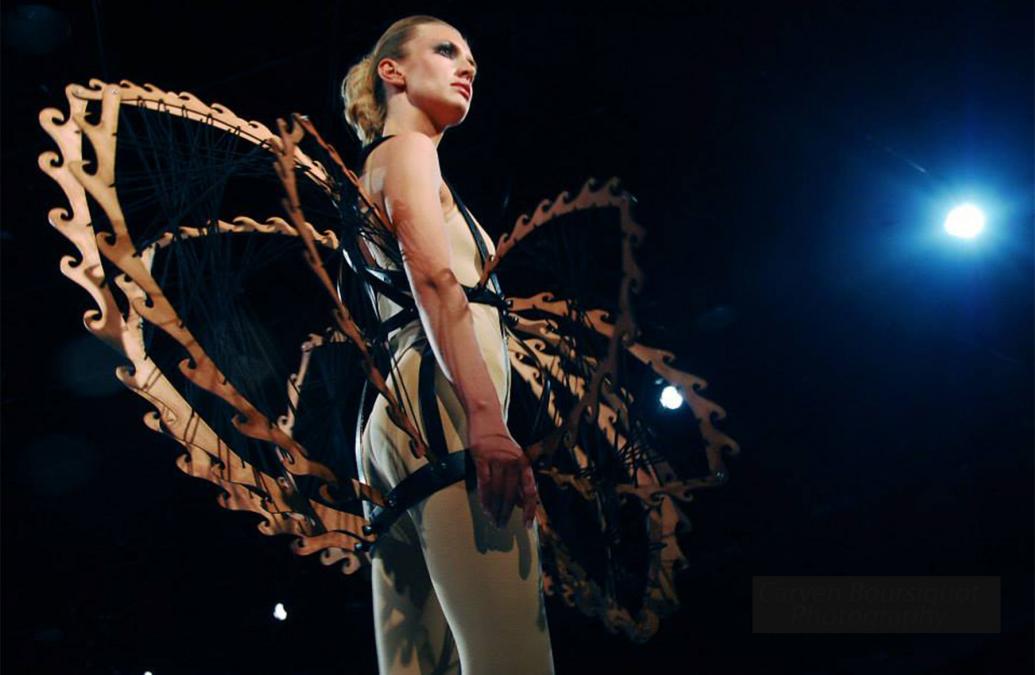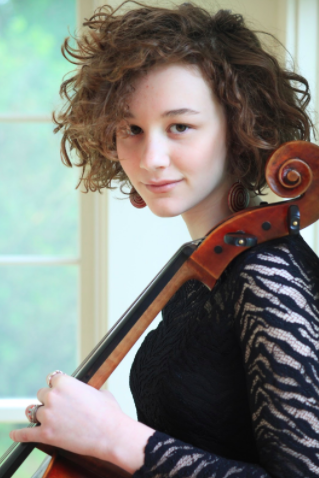Mindfulness Through Music and Movement: SIF Kate Reed’s Vision of Musical Prosthetics

A model wearing a musical prosthetic that Kate Reed designed.

Social Innovation Fellow Kate Reed.
Last year, when looking at her resume, Kate Reed noticed a pattern: time and time again, the design projects she worked on incorporated a desire to create a positive social impact. First, there was the 3-D-printed wheelchair attachment. Next, there were floating dodecahedron orbs that guided users through a Tai Chi routine. Now, there are musical prosthetics, which Reed is developing this year through the Swearer Center’s Social Innovation Fellowship.
These “interactive wearable sculptures” aren’t necessarily what one might envision upon hearing the word “prosthetics” – they don’t serve to replace a missing limb, but rather to detect a wearer’s movements and convert them into sound. This will force the wearer to slow down and become fully aware of each and every one of their movements, therefore creating a sense that they are “one with their body.”
The main goal, Reed says, is to create opportunities for mindfulness.
“I feel like we’re living in a very fast-paced, high-pressure society where everybody’s on social media and everything’s about who can do it first,” she said in an interview. “[With the musical prosthetics,] I want to create that extra second, a kind of inflection point of mindfulness in someone’s day.”
Reed, a musician herself, originally conceived the idea of a musical prosthetic back when she was a senior at NuVu Studio, an alternative, project-based high school. Though she wanted to continue pursuing the project, it never seemed like the right time, and she never had the right resources – that is, until she became a Social Innovation Fellow.
When she learned last semester about the fellowship, which offers students year-long mentorship and $4,000 of funding for a creative venture of their own design, Reed knew she had to apply. “I was like, ‘Wow, I need this knowledge, I want all of these weekly meetings, this is what I want to learn at my time at Brown. How do I make that happen?’” Reed said. “So then I kind of went into [the collection] of projects I wanted to pursue and picked one that felt right, which ended up being the musical prosthetics project.”
Through the fellowship, Reed will spend ten weeks this summer turning her vision into a reality. First, however, her goal is to determine exactly what the final product will look like.
The whole point of the prosthetics is to create music, but this could be achieved in a few different ways. When originally designing the project in high school, Reed chose to make music electronically, through flex, light, and pressure sensors connected to the prosthetic. Now, she’s considering another option: acoustic ‘music.’ In this version, body movements would create sounds directly, perhaps through bands attached to the prosthetic that would stretch as the wearer moved.
Once Reed has decided what kind of sounds to use, she must also determine the form her final project will take. She could arrange a musical dance performance in a theater, an option she might choose simply out of feasibility. Alternatively, she could pursue a more community-oriented option, and have “regular humans” wear her design out in the world in their daily lives. She’s also contemplating combining these first two options and coordinating a performance of dancers wearing the prosthetics in a public, unsuspecting space, such as Kennedy Plaza.
Reed wants the public to witness these musical prosthetics so that many people, not just the wearer, can benefit. Her goal, after all, is to create opportunities for mindfulness, and she believes that interactive art does this almost inherently.
“Whenever [you] go to an art museum or interactive thing, all of a sudden you’re in a room with a bunch of other kindergarteners who are all just playing. Creating these experiences where communities can form and where meaningful connections can happen is very important to me,” Reed said. “You have to give people, especially grownups, the chance to be able to discover something and have a sense of wonder.”
Watch the video below to see Reed's body accordion musical prosthetic in action:
Video courtesy of Kate Reed and the NuVu Studio. All photos courtesy of Kate Reed.
